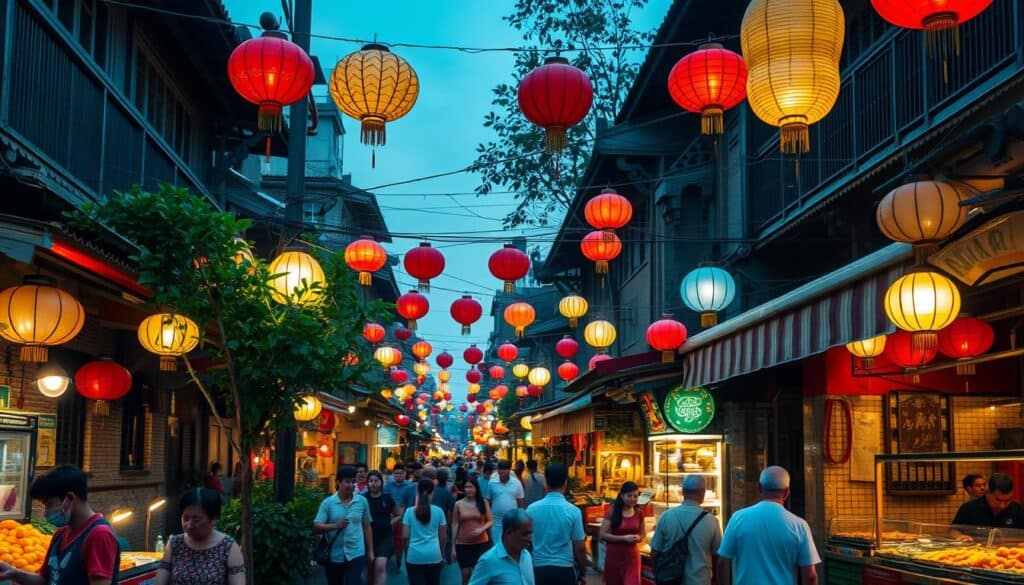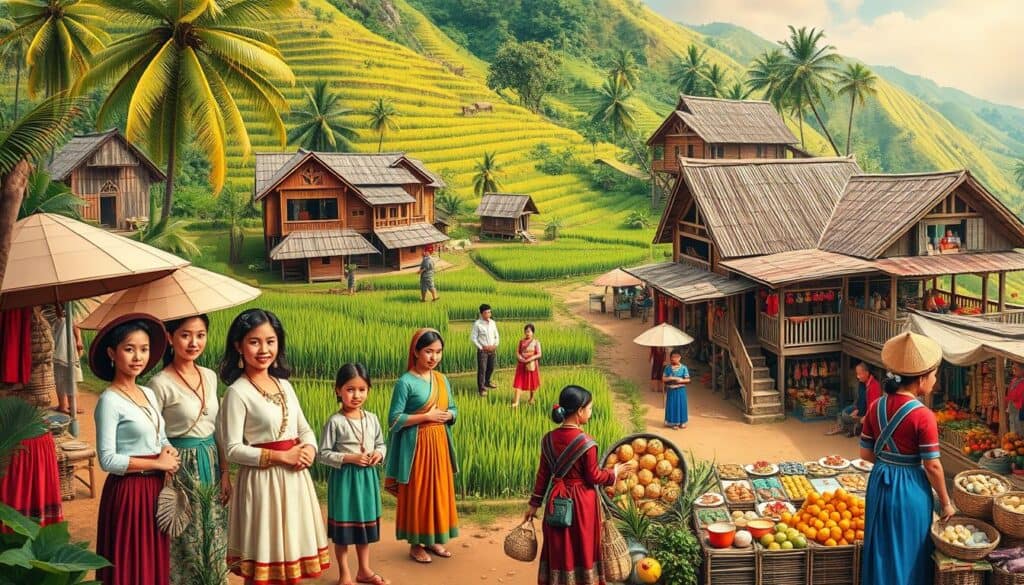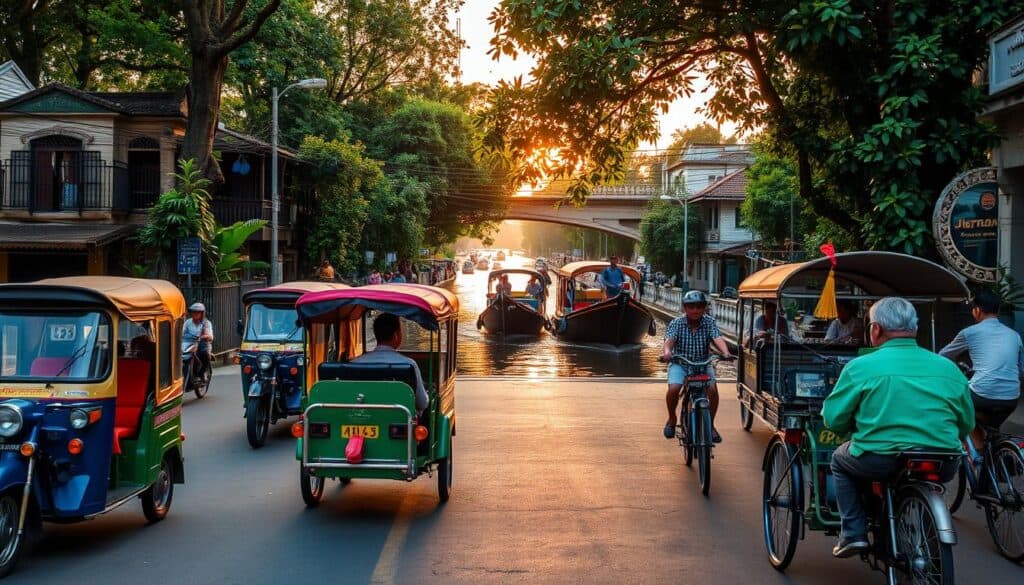Indochine, a region in Southeast Asia, is known for its rich history and vibrant culture, which is reflected in its unique blend of French and Vietnamese cuisine. The Indochine style, which emerged during the French colonial period, showcases a cultural convergence between European colonial elegance and Southeast Asian craftsmanship. From the bustling streets of Hanoi to the tranquil landscapes of Laos, Indochine is a destination that offers something for every kind of traveler, with its French restaurant and Vietnamese cuisine being a major draw.
Imagine yourself in a French restaurant, surrounded by the vibrant colors and intricate patterns of Indochine design, savoring the delicious flavors of Vietnamese cuisine. The color palette of Indochine interiors, which typically includes deep hues like jade green, indigo, and burgundy, adds to the allure of this region. With its rich history, unique culture, and exquisite cuisine, Indochine is a must-visit destination for any traveler.
As you explore Indochine, you will discover the perfect blend of European colonial elegance and Southeast Asian craftsmanship, reflected in its Indochine design and Vietnamese cuisine. Whether you are interested in history, culture, or food, Indochine has something to offer, making it an ideal destination for travelers looking to experience the best of Southeast Asia, including its French restaurant and local markets.
Key Takeaways
- Indochine is a region in Southeast Asia known for its rich history and vibrant culture.
- The Indochine style reflects a cultural convergence between European colonial elegance and Southeast Asian craftsmanship.
- Indochine cuisine is a unique blend of French and Vietnamese flavors.
- The region offers a range of destinations, from bustling cities to tranquil landscapes.
- Indochine is a must-visit destination for any traveler looking to experience the best of Southeast Asia.
- The Indochine cruise is a great way to explore the region, with its 8-day journey from Vietnam to Cambodia or from Cambodia to Vietnam.
Discover the Cultural Richness of Indochine
Indochine culture is a unique blend of history and heritage, shaped by the region’s strategic location at the crossroads of Asia. The Indochine culture is characterized by a mix of traditional and modern elements, with a strong emphasis on festivals and traditions. From the ancient temples of Angkor Wat to the vibrant festivals of Vietnam, Indochine is a treasure trove of cultural experiences.
The region’s history is marked by the blending of French and Vietnamese cultures, resulting in a unique Asian fusion of traditions and customs. Some of the key traditions and festivals in Indochine include:
- New Year (Tet) celebrations in Vietnam
- Water Festival (Bonn Om Touk) in Cambodia
- Boun Pi Mai (New Year) in Laos
These festivals and traditions are an integral part of the Indochine culture and offer a glimpse into the region’s rich heritage. With its unique blend of history, culture, and traditions, Indochine is a fascinating destination for travelers and culture enthusiasts alike.
In conclusion, the cultural richness of Indochine is a unique and fascinating aspect of the region, with a blend of history, heritage, festivals, and traditions that set it apart from other destinations in Asia.
| Country | Festival | Description |
|---|---|---|
| Vietnam | Tet | New Year celebrations |
| Cambodia | Bonn Om Touk | Water Festival |
| Laos | Boun Pi Mai | New Year celebrations |
Culinary Delights of the Region
Indochine cuisine is a fusion of French and Vietnamese flavors, offering a unique culinary experience. With 54 ethnic groups in Vietnam, each with its own distinct culinary traditions, the region is a paradise for foodies. From the spicy curries of Cambodia to the fresh seafood of Vietnam, Indochine cuisine is a blend of Asian fusion and fine dining.
The region’s cuisine is divided into three main categories: Northern, Central, and Southern Vietnamese cuisine. Northern Vietnamese cuisine is known for its simplicity and freshness, with popular dishes like pho and banh cuon. Central Vietnamese food is bold and spicy, with dishes like bun bo Hue and mi quang. Southern Vietnamese cuisine is sweet and sour, with a variety of seafood dishes.
- Trying traditional Vietnamese dishes like pho and banh mi
- Exploring the street food scene in cities like Hanoi and Ho Chi Minh
- Visiting local markets and trying fresh produce and seafood
With its rich culinary heritage and diverse regional variations, Indochine is a must-visit destination for anyone who loves Indochine cuisine and Vietnamese cuisine. Whether you’re a foodie or just looking to try new flavors, Indochine has something to offer.
| Cuisine | Characteristics |
|---|---|
| Northern Vietnamese | Simple, fresh, and light |
| Central Vietnamese | Bold, spicy, and rich |
| Southern Vietnamese | Sweet, sour, and seafood-based |
Breathtaking Landscapes and Natural Wonders
Indochine is home to a diverse range of natural wonders, including stunning Indochine landscapes, national parks, and coastal gems. From the majestic waterfalls of Laos to the pristine beaches of Vietnam, the region is a treasure trove of natural beauty.
Some of the most notable natural wonders in Indochine include Ha Long Bay, a UNESCO World Heritage Site in Vietnam, and Phong Nha-Ke Bang National Park, home to the world’s biggest cave, Hang Son Doong. These national parks and coastal gems offer a glimpse into the region’s incredible biodiversity and geological formations.
Here are some of the top natural wonders to explore in Indochine:
- Ha Long Bay, Vietnam
- Phong Nha-Ke Bang National Park, Vietnam
- Cua Dai Beach, Hoi An
- Marble Mountains, Da Nang
With its rich natural heritage and stunning Indochine landscapes, the region is a must-visit destination for nature lovers and adventure seekers. Whether you’re interested in exploring national parks, relaxing on beaches, or discovering coastal gems, Indochine has something to offer.
| Natural Wonder | Location | Description |
|---|---|---|
| Ha Long Bay | Vietnam | UNESCO World Heritage Site featuring limestone islands and emerald waters |
| Phong Nha-Ke Bang National Park | Vietnam | Home to the world’s biggest cave, Hang Son Doong |
| Cua Dai Beach | Hoi An, Vietnam | Pristine beach with clear waters and powdery sand |
Vibrant Cities and Urban Experiences
Indochine cities offer a unique blend of urban experiences, rich history, and cultural heritage. Cities like Hanoi, Ho Chi Minh City, and Phnom Penh are must-visit destinations for travelers looking to immerse themselves in the region’s vibrant atmosphere.
When exploring these cities, visitors can experience the local way of life, try delicious street food, and visit famous landmarks. For example, in Hanoi, visitors can walk around the Old Quarter, visit the Dong Xuan Market, and enjoy a traditional Vietnamese coffee. In Ho Chi Minh City, visitors can explore the War Remnants Museum, visit the Notre Dame Cathedral, and take a stroll along the Saigon River.
In Phnom Penh, the capital city of Cambodia, visitors can visit the Royal Palace, explore the National Museum, and take a stroll along the Mekong River. These cities offer a wide range of urban experiences, from bustling streets and markets to historic landmarks and cultural attractions.

- Ho Chi Minh City’s Cu Chi Tunnels, a network of underground tunnels used during the Vietnam War
- Hanoi’s Ha Long Bay, a stunning natural wonder with over 1,600 limestone islands and islets
- Phnom Penh’s Angkor Wat, a UNESCO World Heritage Site and one of the largest temple complexes in the world
These cities are a testament to the region’s rich history and cultural heritage, and offer a unique and unforgettable urban experience for visitors.
| City | Country | Must-visit attractions |
|---|---|---|
| Hanoi | Vietnam | Old Quarter, Dong Xuan Market, Ha Long Bay |
| Ho Chi Minh City | Vietnam | War Remnants Museum, Notre Dame Cathedral, Cu Chi Tunnels |
| Phnom Penh | Cambodia | Royal Palace, National Museum, Angkor Wat |
Unique Travel Experiences in Indochine
Indochine travel experiences offer a diverse range of activities that cater to different interests and preferences. From adventure activities to wellness and spa retreats, there’s something for everyone in this vibrant region. With over 30 years of experience in providing private family adventures in Vietnam, tour operators can help plan the perfect itinerary for a memorable trip.
Some popular adventure activities to enjoy in Indochine include trekking, kayaking, and exploring the region’s stunning natural landscapes. For those seeking relaxation and rejuvenation, wellness and spa retreats are available, offering a range of treatments and therapies to soothe the mind and body. With a focus on sustainable travel and social responsibility, many tour operators in Indochine support local communities and conservation efforts, making it possible for travelers to make a positive impact on the environment and local people.
Adventure Activities to Enjoy
- Trekking through emerald green paddies and bucolic river valleys
- Kayaking in pristine beaches and coastal areas
- Exploring historic and cultural sites, such as ancient temples and monuments
Wellness and Spa Retreats
Indochine is home to numerous wellness and spa retreats, offering a range of treatments and therapies, including massages, yoga, and meditation. With a focus on using locally grown and organic ingredients, many retreats provide healthy and delicious meals, making it the perfect destination for those seeking a holistic and rejuvenating experience.
With its rich cultural heritage, stunning natural landscapes, and diverse range of activities, Indochine is an ideal destination for travelers seeking unique and unforgettable experiences. Whether it’s adventure activities, wellness and spa retreats, or simply exploring the local culture and cuisine, Indochine has something to offer every kind of traveler.
| Activity | Location | Duration |
|---|---|---|
| Trekking | Vietnam | 3-5 days |
| Kayaking | Cambodia | 2-4 days |
| Wellness and Spa Retreats | Laos | 5-7 days |
Traditional Art Forms and Handicrafts
Indochine is renowned for its rich tradition of art forms and handicrafts, with local artisans creating unique and beautiful pieces. The region offers a diverse range of traditional art forms and handicrafts, including Vietnamese silk embroidery, lacquerware, and bamboo crafts.
Local artisans in Indochine are skilled in various crafts, such as wood carvings, textiles, and ceramics. Their handicrafts make popular souvenirs and gifts, showcasing the region’s cultural heritage. Some notable Indochine art forms include:
- Vietnamese silk embroidery, which requires weeks to complete a masterpiece
- Lacquerware, with a creation process that can take several weeks to months
- Bamboo crafts, which involve harvesting, stripping, treating, and curing bamboo
These traditional art forms and handicrafts are not only beautiful but also reflect the region’s history and cultural identity. Visitors to Indochine can find these unique souvenirs and gifts in local markets and shops, supporting local artisans and their craft.
By exploring the traditional art forms and handicrafts of Indochine, visitors can gain a deeper understanding of the region’s cultural richness and diversity. Whether it’s a beautifully crafted lacquerware box or a delicate silk embroidery piece, these handicrafts make meaningful souvenirs and gifts, showcasing the region’s unique cultural heritage.
| Art Form | Description |
|---|---|
| Vietnamese Silk Embroidery | A traditional art form that requires weeks to complete a masterpiece |
| Lacquerware | A craft that involves a creation process that can take several weeks to months |
| Bamboo Crafts | A craft that involves harvesting, stripping, treating, and curing bamboo |
Sustainable Tourism Practices in Indochine
As the region of Indochine continues to grow in popularity, it’s essential to prioritize Indochine sustainable tourism practices. This involves adopting eco-friendly travel habits and supporting responsible tourism initiatives. By doing so, travelers can help preserve the region’s natural beauty and unique cultural heritage.
One way to promote sustainable tourism is by choosing accommodations that have implemented environmentally friendly policies. For example, some resorts have replaced plastic water vessels with glass ones, while others have eliminated the use of plastic straws. Additionally, many cruise operators in the region, such as Indochine Sails, encourage passengers to use eco-friendly products and reduce their use of plastic shopping bags.
Travelers can also contribute to responsible tourism by supporting local communities and promoting traditional handicrafts. This can be achieved by purchasing local products, visiting local markets, and engaging with local artisans. By doing so, travelers can help preserve the region’s cultural heritage and support the local economy.
Some notable initiatives in the region include Vinpearl’s efforts to reduce plastic waste and promote sustainable tourism practices. As a major resort chain in Vietnam, Vinpearl has established over 45 facilities across 17 provinces, offering a range of eco-friendly travel options and experiences. With its brand value growing by 34% in the past year, Vinpearl is an excellent example of a company prioritizing Indochine sustainable tourism practices.
Indochine’s Diverse Communities and Ethnic Groups
Indochine is home to a diverse range of communities and ethnic groups, each with their own unique culture and traditions. The region’s cultural interactions and influence can be seen in the various ethnic groups that inhabit the area, including the Vietnamese, Khmer, and Thai. These ethnic groups have their own distinct customs, languages, and beliefs, which have been shaped by their history, geography, and cultural exchanges.
The cultural interactions and influence among the ethnic groups in Indochine have resulted in a rich and vibrant cultural heritage. For example, the Vietnamese and Khmer communities have exchanged cultural practices, such as music and dance, while the Thai community has introduced its own unique culinary traditions. This cultural diversity has contributed to the region’s dynamic and cosmopolitan atmosphere, making it an exciting and fascinating place to explore.

- Vietnamese
- Khmer
- Thai
- Chinese
- Other ethnic minorities
These ethnic groups have their own distinct identities and cultural practices, which have been shaped by their history, geography, and cultural interactions. Understanding and appreciating these cultural differences is essential to exploring and experiencing the rich cultural heritage of Indochine.
Important Landmarks and Historical Sites
Indochine is home to a plethora of historical sites and landmarks, including numerous UNESCO World Heritage Sites. These sites showcase the region’s rich cultural and historical heritage, with many dating back centuries. Some of the most notable sites include the ancient city of Angkor Wat, the historic landmarks of Hanoi, and the majestic temples of My Son Sanctuary.
Visitors to Indochine can explore eight UNESCO World Heritage Sites in Vietnam and two in Cambodia. These sites are a testament to the region’s diverse cultural and historical significance, with each one offering a unique glimpse into the past. From the stunning natural beauty of Ha Long Bay to the intricate carvings of the temples at My Son Sanctuary, there is no shortage of incredible landmarks to discover.
Some of the must-visit historical sites and landmarks in Indochine include:
- Angkor Wat in Cambodia, one of the largest religious monuments in the world
- My Son Sanctuary in Vietnam, a complex of Hindu temples dating back to the 4th century
- Ha Long Bay in Vietnam, a stunning natural wonder featuring over 1,500 limestone islands and islets
- Hoi An Ancient Town in Vietnam, a charming town filled with historic architecture and vibrant culture
These historical sites and landmarks are not only important for their cultural and historical significance but also for their natural beauty. Many of these sites are located in stunning natural surroundings, making them a must-visit destination for anyone traveling to Indochine.
| Country | Number of UNESCO World Heritage Sites |
|---|---|
| Vietnam | 8 |
| Cambodia | 2 |
| Laos | 3 |
Navigating Transportation in Indochine
Indochine transportation offers a range of options for travelers, making it easy to explore the region. When traveling between countries, it’s essential to consider the available transportation options. Indochine’s transportation network includes buses, trains, taxis, and rental cars, providing flexibility for travelers.
One of the most popular transportation options in Indochine is the train. The Reunification Express, which runs between Saigon and Hanoi, is a convenient way to travel between the two cities. With over 6 trains per day, travelers can choose from a variety of classes, including Hard Seat, Soft Seat, 6-Bed Sleeper, and 4-Bed Sleeper. The journey takes over 32 hours, but the scenic views and comfortable seating make it a worthwhile experience.
Available Transportation Options
- Buses: an affordable option for short distances
- Trains: a convenient way to travel between cities, with various classes to choose from
- Taxis: a quick and easy way to get around cities
- Rental cars: a great option for exploring the countryside
When traveling between countries, it’s crucial to plan ahead and research the best transportation options. Indochine transportation is relatively affordable, and with some planning, travelers can easily navigate the region. Whether by train, bus, or taxi, Indochine’s transportation network makes it easy to explore the region’s rich culture and stunning landscapes.

Accommodations: Where to Stay
Indochine offers a wide range of accommodations, from luxury resorts and hotels to affordable backpacker options. Travelers can choose from various options, including 5-star hotels like the Indochine Palace in Hue, Vietnam, which provides numerous amenities such as a fitness center, non-smoking rooms, and an outdoor swimming pool.
For those on a budget, there are many affordable backpacker options available, including guesthouses and hostels. Some popular destinations for backpackers include Laos and Cambodia, which offer a mix of culture, adventure, and natural beauty. Indochine accommodations cater to all types of travelers, ensuring a comfortable and enjoyable stay.
Here are some options to consider:
- Luxury resorts: Indochine Palace, The Residence Indochine d’Angkor Hotel
- Hotels: various options in major cities like Hanoi, Ho Chi Minh City, and Phnom Penh
- Backpacker options: guesthouses, hostels, and budget-friendly hotels
When choosing Indochine accommodations, consider factors such as location, amenities, and price. Many luxury resorts and hotels offer special packages and discounts, making them more affordable for travelers. Backpacker options are also available, providing a budget-friendly alternative for those looking to explore Indochine without breaking the bank.
| Accommodation Type | Price Range | Amenities |
|---|---|---|
| Luxury Resorts | $100-$500 per night | Fitness center, outdoor swimming pool, spa and wellness center |
| Hotels | $50-$200 per night | Non-smoking rooms, room service, free parking |
| Backpacker Options | $10-$50 per night | Shared rooms, communal kitchen, free Wi-Fi |
Planning Your Indochine Adventure
With its rich cultural heritage, captivating landscapes, and diverse culinary delights, Indochine is a region that deserves thorough exploration. As you plan your journey, consider the best times to visit. The dry season from November to April is the most popular, offering pleasant weather and fewer crowds. However, the lush greenery and reduced prices during the rainy season from May to October may also appeal to adventurous travelers.
Essential Travel Tips and Resources
When preparing for your Indochine adventure, keep in mind the relatively low cost of living in the region. A budget of around PHP 40,000-50,000 (approximately $800-$1,000 USD) for an 11-day trip, including flights, accommodations, and meals, can be sufficient. Accommodations can be booked through platforms like Hostelworld.com, Agoda.com, or Airbnb. With expert guidance from seasoned local tour operators like Indochina Adventure, you can ensure a seamless and enriching experience.
As you explore the Indochine countries of Vietnam, Laos, and Cambodia, be sure to consult our comprehensive guide on the must-see destinations, transportation options, and essential travel tips. By planning ahead and utilizing the wealth of resources available, you’ll be well on your way to an unforgettable journey through the captivating Indochine region.
